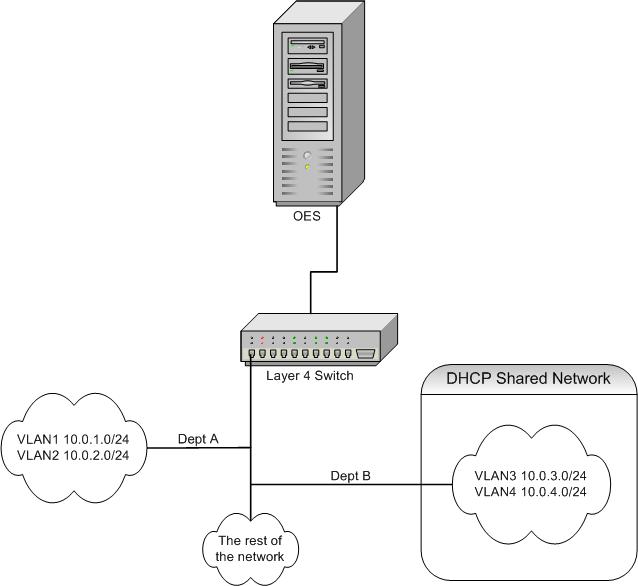Environment
Novell DHCP
Novell Open Enterprise Server 2 Support Pack 1 (OES 2 SP 1) Linux
Situation
The OES documentation, under section 1.4.2, states the following about the "Shared Network" option under DHCP:
"All subnets that share the same physical network can be grouped under a Shared Network object.
Some installations have physical networks on which more than one IP subnet operates. For example, if there is a site-wide requirement that 8-bit subnet masks be used, but a department with a single physical Ethernet network expands to the point where it has more than 254 nodes, it might be necessary to run two 8-bit subnets on the same Ethernet until a new physical network can be added. In this case, the subnet declarations for these two networks must be enclosed in a shared-network declaration.
A shared network object must be created under a service object."
This TID is to clarify the above statement, and to state what the shared network option does and does not do.
Resolution
Assume the following network setup:
VLAN 1: 10.0.1.0 Mask 255.255.255.0
VLAN 2: 10.0.2.0 Mask 255.255.255.0
VLAN 3: 10.0.3.0 Mask 255.255.255.0
VLAN 4: 10.0.4.0 Mask 255.255.255.0
Assume the following DHCP setup on the OES server (for reference, this information is from the /var/log/dhcp-ldap-startup.log):
| Note that both subnet declarations for both VLAN 3 and 4 are located within the shared-network configuration (called "MySharedNetwork") | |
| subnet 10.0.1.0 netmask 255.255.255.0 { default-lease-time 259200; max-lease-time 259200; pool { range 10.0.1.1 10.0.1.251; } } | Note the subnet configurations for both VLAN 1 and 2 look the same as the subnet configurations for VLAN 3 and 4; however, they DO NOT fall under the shared network configuration. When creating a subnet, the administrator can choose to create the subnet within a shared network or not. It is only an option, and not a requirement (as a shared network was designed for a specific purpose) | |
| subnet 10.0.2.0 netmask 255.255.255.0 { default-lease-time 259200; max-lease-time 259200; pool { range 10.0.2.1 10.0.2.251; } } |
Assume the following network layout:
In the above scenario, when clients on VLAN 1 request a DHCP address from the OES server, the client will receive a 10.1.0.x address. Similarly, clients on VLAN 2 will receieve a 10.2.0.x address when a request is sent to the OES DHCP server. However, DHCP Shared Networks act differently.
Refer to the snipit from the documentation above. Assume DEPT B has 350 employees. VLAN 3 or 4, in and of themselves, will not have a sufficient number of available DHCP addresses should all employees be in the office and logged in. DEPT B, being short on cash, cannot setup a physical network to address their expansion concerns; however, new hardware isn't needed in order to assign more DHCP addresses to DEPT B. If the system administrator setups a new subnet inside of DHCP, and assigns it to a shared network, and then does the same for another subnet (NOTE: All subnets must share the same physical network).
In the above example, VLANs 3 and 4, representing the 10.0.{3,4}.0/25 subnets, have been grouped together under a DHCP shared network. Assume that a pool has been created for each subnet in which 250 addresses are share out. When a client from DEPT B requests a DHCP address, they may receive either a 10.0.4.x address or a 10.0.3.x address. Likely, the DHCP server will start with the highest address possible, and hand out addresses from there--meaning the server will likely hand out 10.0.4.251, then 250, then 249, and so on until the 10.0.4 x addresses are depleted. The server will then hand out the 10.0.3.251 address, and so on and so forth.
In the case of VLAN 1 and 2, where the subnets were created OUTSIDE of a shared network, the administrator has control over which VLAN recieves which addresses (at least as far as the subnet is defined). In the case of VLAN 3 and 4, from a DHCP perspective, the clients are on the same network and the administrator does not control which clients will receive addresses from a specific VLAN (other than the subnets created under the shared network).
